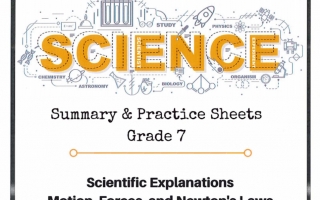SCIENCE
Summary & Practice Sheets
Grade 7
Scientific Explanations Motion, Forces, and Newton's Laws Foundations of Chemistry Understanding the Atom The Periodic Table
The Scientific Method
1. Make Observations
(use your senses to gather information)
2. Ask a Question ?
3. Formulate a Hypothesis
(explanation that can be tested)
4. Test a Hypothesis (design an experiment, research, or more observations)
5. Collect Data
6. Draw a Conclusion
(a written summary that states whether the hypothesis is correct or not)
Measurement and Scientific Tools
Scientists across the world use a measurement system called the International System of Units (SI).
Many different tools can be used to collect both quantitative and qualitative data.
graduated cylinders
scale
ruler
thermometer
microscope
UNITS:
Length: meter (m)
Mass: kilogram (kg)
Time: second (s)
Temperature: Kelvin (K)
Accuracy is how close a measurement is to the true value.
Precision is the degree to how close measurements are to other measurements taken the same way.
Data should be both accurate and precise!
MOTION!
An object is in motion when it is changing its position based on a reference point.
Scalar
physical quantity that has only magnitude
example: length, distance, temperature
Vector
physical quantity that has magnitude and direction
example: weight, displacement, force
Speed is how fast an object is traveling.
Velocity is speed in a given direction.
Representing motion using graphs
A displacement-time graph shows the relationship between the displacement traveled by an object and time.
The speed-time graph below shows the relationship between speed and time.
Forces push or pull
Contact forces
forces between objects that are touching
Non-contact forces
forces between objects that are touching
magnetic force
Revision Sheet
Chapter 2- Motion, Forces, and Newton's Laws
Part A- True/False
Indicate whether the statement is true or false.
1. To calculate speed, multiply the distance by the time.
2. The average speed of a moving object is equal to the total distance traveled plus the total amount of time taken to travel it.
3. To calculate average speed, use only the total time and the total distance.
4. To find an object's velocity, you must know the speed and direction of the moving object
5. Weight is the upward force of Earth's gravity on all objects.
6. There is only one type of force.
7. The metric unit which measures force is the Newton.
8. Net force is one force acting on an object.
Part B- Multiple Choice
Identify the choice that best completes the statement or answers the question.
9. Runners competing in a race speed up and change direction as they run around a track. The runners are ..........
a. increasing electrical energy
b. increasing potential energy
c. accelerating
d. decelerating
10. Newton's third law of motion states that for every action there is an equal and opposite ..............
a. acceleration
b. mass
c. force
d. reaction
11. A change in an object's position is called ..........
a. motion
b. velocity
c. distance
d. acceleration
12. An object at rest tends to stay at rest, and an object in motion tends to stay in motion. Which one of Newton's laws of motion does this statement represent?
a. fourth
b. third
c. second
d. first
13. If you walk 1.5 kilometres in 30 minutes what is your average speed?
a. 10 km/h
b. 75 km/h
c. 0.5 km/h
d. 1.0 km/h
14. If you know the speed and direction of an object, which could you find?
a. acceleration
b. velocity
c. size
d. apparent motion
15. Any push or pull on an object is called a ...........
a. lift
b. force
c. thrust
d. friction
16. As the distance between two objects increases, the gravitational force between the objects ........... ?
a. increases
b. decreases
c. creates friction
d. stays the same
17. Acceleration is a change in the ........... of an object over time.
a. speed
b. direction
c. motion
d. velocity
18. An airplane travels 290 km between Austin and Dallas in 1 h and 15 min. What is its average speed?
a. 160 km/h
b. 200 km/h
c. 232 km/h
d. 250 km/h
19. When net forces are equal in strength and opposite in direction, they are said to be .............
a. balanced
b. unbalanced
c. negative
d. opposite
20. Which represents a force pair?
a. A book pushes down on the table, and gravity pulls the book down toward the floor.
b. A boy's foot pushes down on a bicycle pedal, the pedal pushes up on his foot
c. A golf club hits a golf ball. Gravity pulls the ball back down to Earth.
d. A person's foot pushes on the floor, and the person's weight pushes on the floor.





